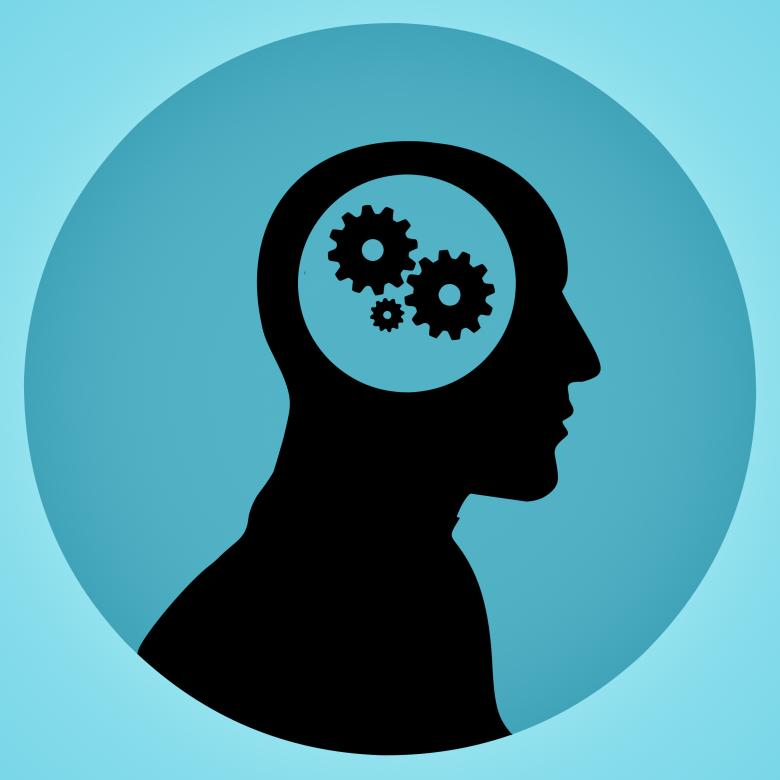Differentiating Process: Making Sense of Our Thinking
 |
| image of cogs turning inside a circle representing a man's brain. |
"Things are simple. Situations are clear. Hurdles are easy. It's our mind which makes it complex and complicated." -Anonymous.
The Behaviorist Perspective. Using motivation through rewards and punishment, behaviorists believe this process causes learning to occur. Initial learning happens when stimulus-response associations occur. As rigor is applied to the stimulus and new responses are displayed based on rewards and consequences, more learning or sometimes reified learning happens. One well known behaviorist includes B.F. Skinner. A popular behaviorist example includes Pavlov and his dogs experiment. When tasks are presented from simplest form to later complex form, students are allowed the opportunity to hone in on the simplest form first so as not to create potholes or gaps in their initial learning. Later, the tasks or content is increased in rigor to allow for new or adjusted associations to form. Using reward or consequence, the association is discarded or added to concrete thinking. When a teacher allows a student to make initial explorations on new content only to confirm or adjust the findings through praise or correction, the behaviorist perspective is being used.
The Cognitive Perspective. When a student knows how to pass, kick, or throw a ball in practice, they still learn and add to their cognition when they have to decide when and how to exert those skills in a real game. This "learning" in the game that builds on the prior knowledge is the basis for the cognitive perspective in thinking. Cognitive theorists believe that students learn or process using schema, or units of knowledge organized to make sense of information. When learning happens, new information is added and logically incorporated into existing knowledge systems, or schemata, which are the organizational systems we create to make sense of the bigger world, or bigger picture. Both declarative knowledge (e.g., facts or recall items) and procedural knowledge (processes) are used in schemata to help students infer and make assumptions in their learning to add more learning.
The Situative Perspective. Even though its sometimes referred to as the sociocultural perspective, this perspective proposes that learning occurs in context or in situations. These contexts (e.g., community, forms of practice, or language vernacular) set the perspective of learning for the student. The context or community can be a sports team, a mentoring circle, or a homeroom group. Students learn in these contexts and with these inherent rules to gather knowledge. The context serves an organizational filter for the student. When asking a student to make sense of their learning through this approach, providing the student opportunities that let them share within the context that they receive the content allows them the freedom share their thinking their way.
Differentiating Process
 |
| image of metacognitive process. |
Strategies. These are some strategies you can use to deepen the metacognitive process as well as help students share their thinking.
Reflective Journals. Using reflective journals, sometimes called interactive journals or dialogue journals, as a metacognitive processing tool allows a teacher to give varying prompts and set a culture for students to answer by drawing, writing, or clipping to organize in their thinking and learning.
Tiered Activities.
Learning Centers.
Graphic Organizers.
Jigsaw Activities.
Manipulatives.
moving images of thinking
References
"3 Advances in the Sciences of Thinking and Learning." National Research Council. 2001. Knowing What Students Know: The Science and Design of Educational Assessment. Washington, DC: The National Academies Press. doi: 10.17226/10019. https://nap.nationalacademies.org/read/10019/chapter/6#63
Bennett, G. K., Seashore, H. G., and Wesman, N. C. Differential Aptitude Tests: Manual. New York: Psychological Corporation, 1977.
Differential Aptitude Test. (accessed February 27th, 2023). Retrieved from https://www.keyano.ca/en/programs-and-courses/differential-aptitude-test-dat.aspx?_mid_=12177#:~:text=The%20DAT%20is%20a%20tool,options%2C%20including%20some%20industrial%20firms.
Image. "Man Thinking Silhouette". (2018). Mohamed Hassan. Accessed February 23rd, 2023. Retrieved from https://www.stockvault.net/photo/253900/man-thinking-silhouette.
Image. "Metacognition". (accessed 2023). Retrieved from https://www.queensu.ca/teachingandlearning/modules/students/24_metacognition.html#:~:text=Metacognition%20is%20the%20process%20of,how%20you%20think%20and%20learn
IRIS Center. (2023). How Do Teachers Differentiate Instruction? Page 6: Differentiate Process. Retrieved from https://iris.peabody.vanderbilt.edu/module/di/cresource/q2/p06/
Michalak, K. (2019, October 3). schema. Encyclopedia Britannica. https://www.britannica.com/science/schema-cognitive
Pankin, J. (2013). Schema Theory. http://web.mit.edu/pankin/www/Schema_Theory_and_Concept_Formation.pdf
University of Cambridge: Engineering Design Centre. (Accessed 2023). Retrieved from http://www.inclusivedesigntoolkit.com/UCthinking/thinking.html#:~:text=Thinking%2C%20also%20known%20as%20'cognition,also%20be%20categorised%20under%20thinking.
More To Come
Check out other blogs breaking down the components of the Differentiated Instruction (DI) framework below:
- Looking at Differentiation...An Overview.
- Differentiating Content
- Differentiating Process
- Differentiating Product
- Differentiating Affect
- Differentiating the Learning Environment
- Teacher Mindset
- Looking at Differentiation...An Overview.
- Differentiating Content
- Differentiating Process
- Differentiating Product
- Differentiating Affect
- Differentiating the Learning Environment
- Teacher Mindset

Comments
Post a Comment